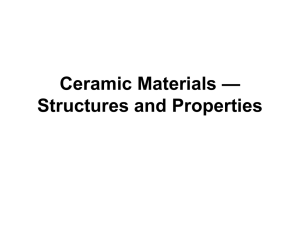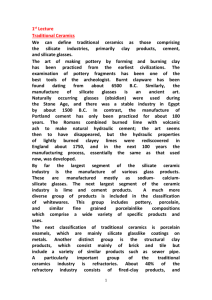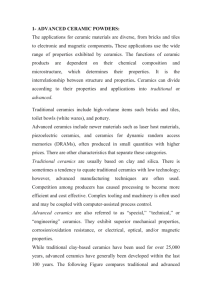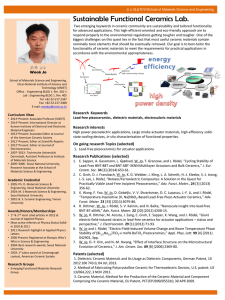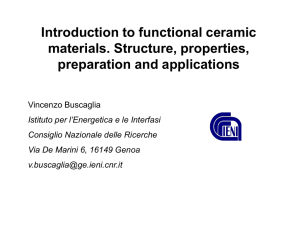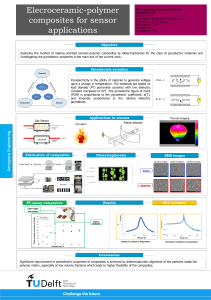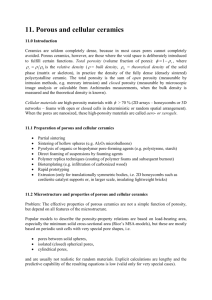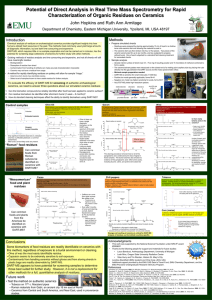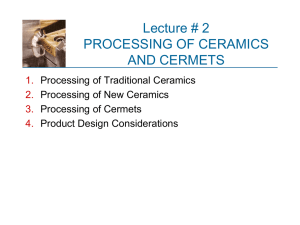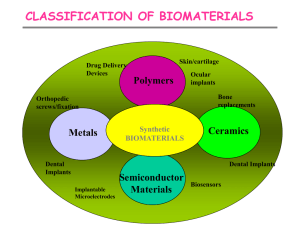Structural ceramics - IENI-CNR
advertisement
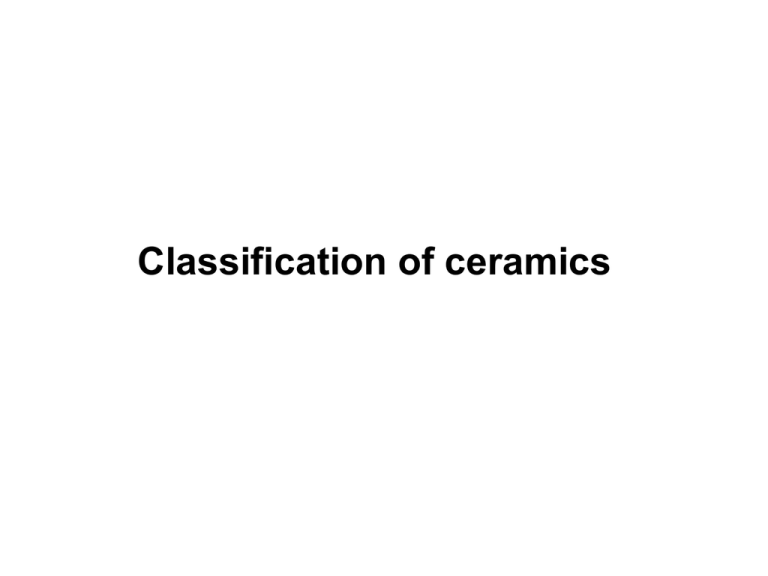
Classification of ceramics What a ceramic is ? From Greek word “keramos” (pottery, potter’s clay) Inorganic nonmetallic materials obtained by the action of heat and subsequent cooling Polycrystalline materials, single phase or multiphase (composites), sometimes with an amorphous component (glass) Traditional ceramics •Whitewares: tableware, cookware, sanitary ware, etc. •Refractories (kiln and furnace linings for steel and glass industry) •Structural clay products (floor & roof tiles, bricks, etc.) Fabricated from clay, quartz, feldspar (earthenware) and kaolin (porcelain) Technical/advanced ceramics •Structural ceramics (mechanical properties: strength, toughness, hardness, creep resistance) •Functional ceramics (electric, magnetic, optical properties) Structural ceramics •Si3N4: bearing balls, cutting tools, heat exchangers, turbocharger rotors, parts of gas turbines •SiC: abrasives, disk brakes, pipes for corrosive liquids, ballistic armors •WC, Ti(C,N): cermets, inserts for cutting tools •B4C: neutron absorber in nuclear plants, ballistic armors, nozzles, abrasives •Al2O3 (alumina): spark plugs, substrates, crucibles, furnace tubes, ballistic armors, thermal insulation •3Al2O3•2SiO2 (mullite) & Mg2Al3(Si5AlO18) (cordierite): catalytic converters, ceramic filters •ZrO2 (zirconia): knifes, watch cases, orthopedic implants, grinding media, thermal barrier coatings •UO2: nuclear fuel •Ca10(PO4)6(OH)2 (hydroxyapatite): biomedical implants, artificial bone Two Kyocera ceramic knives Ceramic body armour plates The Porsche Carrera GT's silicon carbide disk brake Ceramic Si3N4 bearing parts Radial rotor made from Si3N4 for a gas turbine engine Functional ceramics Functionality Material Applications Resistors SiC, MoSi2, LaCrO3 Heating elements for high temperature furnaces Thermistors (NTCR & PTCR) Spinels BaTiO3 Temperature sensors, self-regulating heating elements Dielectrics with very low losses (r = 3 -10) Al2O3, AlN, cordierite Substrates for electronic circuits and chip packaging Dielectrics for microwave applications (r = 30-80) BaTi4O9, Zr(Ti,Sn)O4, BaMg1/3Ta2/3O3, (Ba,Sr)TiO3, MW resonators, filters and antennas for mobile communications and GPS devices, tunable MW devices Temperature stable dielectrics (r 100) CaTiO3, BaONd2O3-TiO2 Capacitors with temperatureindependent capacitance Dielectrics with very high dielectric constant (r 3000) BaTiO3 Multilayer ceramic capacitors Piezoelectric ceramics Pb(Zr,Ti)O3 (PZT) Transducers, actuators and resonators Pyroelectric ceramics Pb(Zr,Ti)O3 IR radiation detection and imaging Functional ceramics Functionality Material Applications Ferroelectric ceramics Pb(Zr,Ti)O3 SrBi2Ta2O9 Ferroelectric memories (FeRAMs) Electrostrictive ceramics PbMg1/3Nb2/3O3 -PbTiO3 (PMN-PT) Actuators Magnetic ceramics Spinels (Ni,Zn)Fe2O4 BaFe12O19 Y3Fe5O12 (YIG) Inductors Permanent magnets Microwave devices (radars) Ionic conductors Y:ZrO2 (YSZ) Gd:CeO2 β-alumina Electrolytes for solid-oxide fuel cells (SOFCs), oxygen sensors Na-Batteries Superconductors YBa2Cu3O7-x (YBCO) MgB2 Superconducting cables for magnets Transparent ceramics Al2O3, MgAl2O4, Y3Al5O12 (YAG) Phosphors, optical materials for lenses and laser systems, nose cones for heatseeking missiles, high-pressure sodium street lamps Optoelectronic materials LiNbO3 PLZT Waveguides, frequency doublers, voltage-controlled optical switches, modulators Thick (left) and thick (right) substrates (alumina) Pressed and extruded parts (alumina, mullite, zirconia) Ferrites cores Microwave dielectric components Microstructure of ceramics Ceramic microstructures SSS 99% Al2O3 – transparent fully dense (“ideal”) ceramic: grains + grain boundaries SSS 99% Al2O3 - ceramic with residual porosity: grains + g.b. + pores LPS 96% Al2O3 - dense ceramic with grain boundary glass phase: grains + glassy phase (CaO*SiO2) + 2 types of g.b. Microstructural variables Density - crystallographic (from unit cell parameters) - theoretical (zero porosity, takes into account real composition) - apparent (geometrical) density (< theoretical) - relative density = (apparent/theoretical)*100 Porosity - closed (only closed above 93% r.d.) - open (pore networks connected to the surface) - intragranular - intergranular Grain size (simplest method: mean intercept length) Grain size distribution (monomodal, bimodal, abnormal grain growth) Grain shape (equiaxed, elongated, prismatic, columnar, tabular, platelets) - aspect ratio (ratio longest/shortest size dimensions) Extended defects (dislocations, stacking faults, twins, domain walls) Second phase composition, shape and distribution Texture (grains oriented in a preferential direction) Types of porosity Intergranular porosity Intragranular porosity Y2O3:ZrO2 (PSZ) ceramic Intra- and intergranular porosity Ba(Ti,Ce)O3 ceramic Closed (intragranular) and open (itergranular channels) porosity Shape of grains and pores gb 120° gb gb Equilibrium shape of grains. Hexagons (2D) and truncated octahedron (3D) Concave pore Convex pore Irregular pore associated with a hard agglomerate Grain size distributions and abnormal grain growth Mg0.1Al1.8Ti1.1O5 ceramics 1450°C/2 h Equiaxed grains with monomodal distribution 1500°C/2 h Some large elongated grains appear: onset of AGG 1550°C/2 h Bimodal distribution related to AGG Revealing microstructure Polished surface Fractography Grain pull-out Cross-sections of Ba(Ti,Zr)O3 ceramics Revealing microstructure Chemical etching Thermal etching Vapour Solid grain Solid grain After polishing Si3N4 Fully-dense alumina After thermal treatment SiC Er-doped BaTiO3 Revealing microstructure Optical microscopy in polarized light Coated Co:WC:Ti(C,N) cermets Revealing microstructure Scanning electron microscopy using backscattered electrons (BEI) Al2O3-(Zr,Y)O2 composite The darker phase is alumina Ba(Ti,Ce)O3 ceramic containing Ce-rich inclusions Spectrum In stats. O Ti Ba Ce Total 1 2 Yes Yes 23.43 22.41 9.37 2.77 58.72 41.71 8.48 33.11 100.00 100.00 Secondary phases in Er-doped BaTiO3 White phase: Er2Ti2O7 Dark gray phase: Ba6Ti17O40



